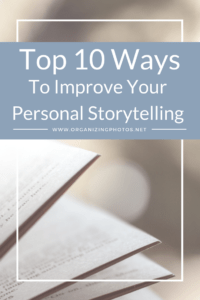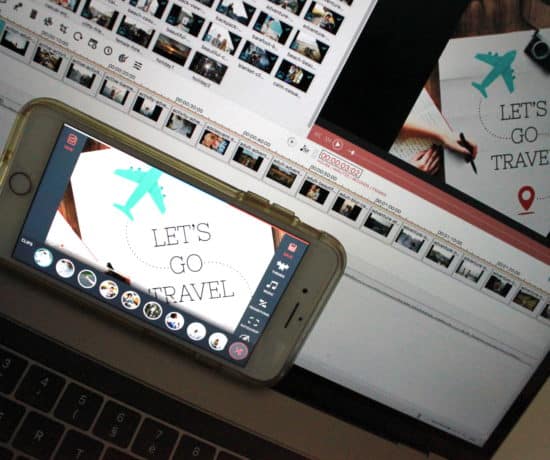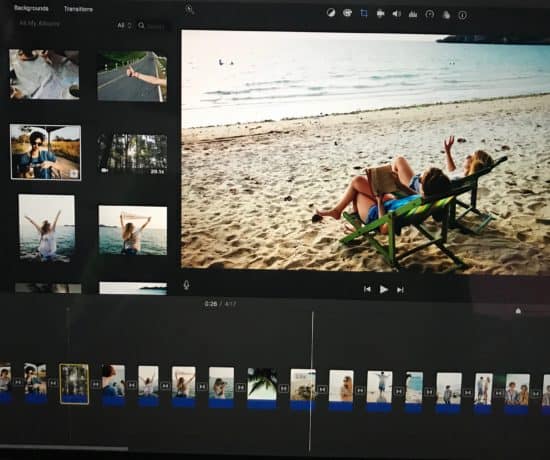On this blog, we talk a lot about the tips and techniques for organizing your photos and memorabilia, but oftentimes, the underlying reason for that gets overlooked. When we take away all the how and whys, it’s really the stories that matter. We want people to do something with their photos. No doubt it starts with the “getting organized” part, but what good is a photo if we don’t know the story behind it? As a Personal Historian, it’s my job to help stories get told, and that’s why Shastina and I decided to compile this list on how to improve your personal storytelling. How do you make it compelling? What do you highlight? And from an entertainment industry point of view, how can you ensure that your story becomes a page-turner? Keep reading to find out! 😉
Personal Storytelling is Relatable
As humans we are constantly looking for something we can relate to. It’s how we learn. It’s how we cope. It’s how we pass on life lessons. And as we shared in this blog post, stories can have a massive impact on our lives. True stories are powerful. There’s a reason why so many movies are based off of true stories. There’s drama, suspense, comedy, tragedy, passion, happiness, and everything in between. We identify with them. They’re real.
Now imagine if your life was a movie. What would happen? Who would play the lead? What would you say? It’s fun to think about, isn’t it? Not only is it fun to think about, it’s fun to do! It’s worth taking the time to create your own personal history. The one you see. The one you went through. Your own journey that nobody else can tell except you. It’s valuable not only as a method of reflection for yourself, but it’s a treasure to those around you. The specific adventures or challenges you went through can give those who didn’t get a chance to know you a clearer picture of who you were and what mattered to you. It’s a time capsule of your life; one that you deserve to have preserved because you matter to more people than you realize.
Start with Your Own Story
It’s easy to put aside personal history storytelling in favor of other genealogy work. We get it. It’s exciting to solve those old mysteries and make those connections. But don’t get so caught up in trying to tell your ancestors’ stories that you forget about your own! Easier said than done, we know, but time gets away from us. Memories fade, and if we wait, we risk our own stories being forgotten. This blog post is here to inspire your to start with your own storytelling and then move on to everyone else’s! You’re the only person in the world who can tell your story the way it’s meant to be told.
Write It…Then Improve It!
Writing your own personal version of Hamilton isn’t necessarily intuitive though. When you put in all that work, you want people to love it. It means getting them to turn the page. Or not fall asleep, at the very least. It means emphasizing and highlighting details of your life that are unique, and placing them in a specific order that makes the reader or listener actively involved. That’s why we created this list for you. By implementing the following tips, you’ll drastically improve your own storytelling and make it shine.
Here’s how you do it…
Tip #1: Gather Ideas in ONE Place
Before you start writing, gather your ideas in one place that you can easily access from anywhere, for example in Evernote. This will help you outline your story in a better way, and it’ll let you use any downtime that you have to compile your story. Just like with your photo organizing, you need that one place that is “home” to all of your stories because it keeps you organized and lets you stop and start again at any point. Apart from Evernote, we also highly recommend Scrivener and Ulysses. All three of them are wonderful writing apps that make your storytelling that much easier!
Tip #2: Bite-Size Writing Works
Working on your storytelling in smaller chunks will make your project seem more manageable. We’re all busy bees, so using those five minutes when you’re waiting in line somewhere is a great way to get stuff done. If you can, set aside a few minutes a day to write, but don’t beat yourself up if you miss a day – just keep at it. If you need some help in that area, check our blog series “Divide & Conquer.” It will teach you how to break down large projects and make them easier and less overwhelming. Don’t try to do it all in one day!
Tip #3: Storytelling Can Take Many Forms
Personal storytelling is personal by definition, so let it flow the way it wants. Don’t feel restricted to what’s “traditionally” been done by others. You content can take many forms, and out-of-the-box thinking is what makes it fun! There are also many ways to get ideas down on digital paper. Don’t think you have to only “write.” You can also dictate on your phone, or if you don’t care for typing, you can always use a digital pen to hand write on a notepad (it’ll send the file directly to your computer). You’re limited only by your creativity!
Tip #3: Create a Structure
How you tell your personal history is up to you, but creating a loose structure or outline after gathering your information could help keep you stay on track. What were the major highlights in your life? The emotional ups and downs? What eras did you live through? You’ll notice that when you watch a good movie or read a great book, there is a strong beginning and end. Make sure to incorporate these. Sometimes even coming up with this first will help you fill in the middle. And yes, you can write out of sequence. See #4.
Tip #4: Write Out of Sequence
Writer’s block usually shows up when your expectations of what should happen don’t align with what actually does happen, so to get over this, write out of sequence. Movies aren’t all shot from beginning to end. They are shot in the most economical and easy way possible – by staging related scenes and props together, even if they’ll show up at the end in the final version. Fixing those things is what editing is for. So just know that you don’t have to start in chronology with your birth and childhood years. You can start by writing about today. You can write about when you got your first job, or when you bought your pet. Anything goes. You only start putting together the puzzle after you have all the pieces.
Tip #5: Write as “You”
You’re the main character, and it’s you that we follow along on the journey. You are who we get to know. It’s you we root for or against in the story. It’s you who we empathize with. This is how we get to know the world you live in, so what does it look like? The good news is that it all depends on the way you write it or tell it. Don’t write in 3rd person. You know…”He said, she said.” Instead, use first person. Write actively when you can, and use present tense instead of past tense. This tends to be much more interesting for the person who reads or listens to what you have to say because it immediately brings them into your story. It’s much more interesting to read a sentence like “I remember the day when…” if the author is clearly you. Think of it as your diary. It’s not what you say, it’s how you say it. It is how a personal history is told that makes all the difference.
Tip #6: Develop the Characters
Just like a movie script, you want to include personalities and eccentricities. When you write about others, identify them by how you remember them and how they made you feel. Did someone talk a certain way? Did they always wear something particular? Or maybe they liked a certain food? It’s all in the details. Little quirks can make all the difference. Got an evil stepmother? We definitely want to know about it!
Tip #7: Celebrate Your Culture
Use your vocabulary and dialect instead of writing a certain way just because it’s “grammatically correct.” Your life isn’t stiff and dry, so your storytelling shouldn’t be either. It’s OK to write how you talk – as long as others can understand it. A great example is using your local vernacular. Do you say “pop” or “soda”? “Pizza” or “pie”? Your language is part of your culture, so include it!
Tip #8: Set the Scene with ALL Your Senses
Great writing evokes a feeling, so use all of your senses in your writing. It’s not just about what you saw, but also about what you felt, tasted, and heard. Set the scene for us. It’s the same with movies, books, and TV shows. That’s why directors pick certain camera shots. It’s why chapters in books might be long or short. It’s why one person may start with a sad opening or an action-oriented opening. For example, the smell of churros may remind you of Disneyland. Or maybe hearing someone play chopsticks on the piano makes you think of the movie “Big”? Let us know about that. It paints the picture we need to really imagine it.
Tip #9: Use Facts Responsibly
Do your family history a favor, and state facts only when you’re 100% sure of what happened. For example, saying “Grandpa was born in Illinois” when you’re not sure if it was Illinois or Ohio can mislead those future genealogists in your family tree. You want to produce a quality personal history from start to finish, so for those times when you’re not quite sure, say something like “According to XYZ, Grandpa was born in Illinois.” If you aren’t sure about how to approach your facts and sources, we have an article here about using the GPS (Genealogical Proof Standard) in your favor. Family history without credibility is simply fiction.
Tip #10: Make Your Family Skeleton Dance
As long as exposing family secrets doesn’t hurt any living person, it makes for a great read. They may difficult to write about, but they’re real. Life isn’t always easy, and it’s OK to say that. We’re all human, and it’ll make you relatable. Sure, it brings your story to life in a less than rosy way, but don’t forget that some of the best and most revered works in history have been tragedies.

I’m a Perfect Pinnable!
Write It, Tell it, Make It Great
We hope you loved these top ten ways to create a quality personal history! Hopefully, you feel motivated and have a clearer direction on how to get started! Print this blog post out to refer back to it, if need be. We’ll be right here cheering you on! The great thing about personal history storytelling is that anyone can do it. All it takes is the will to want it and some motivation to stick with it. Put any fears you have about writing behind you because the only way to do it wrong is to not do it at all!
What say you, readers? Got any tips of your own? Share them with us in the comments!
Featured Photo by Caio Resende
Join the Community!
Subscribe to get our latest content by email. You will also get occasional notifications about new sales and promotions.
Please read our Privacy Policy!




